#spatial intervention
Explore tagged Tumblr posts
Video
Narratives of Birth : Poetics of Memory #4 by Russell Moreton Via Flickr: Architectural Intervention : Working Collage for Glass Fetal Medicine Centre Prosound SSD-5000 V4 ALOKA Astronomical Mapping/ Birth Scan Scale, Interior, Time, Spatial Presences, Human Becoming,
#Architectural#Intervention : Working Collage for Glass#Fetal Medicine Centre#Prosound SSD-5000 V4 ALOKA#Astronomical Mapping/ Birth#Scan Scale#Interior#Time#Spatial Presences#Human Becoming#low contrast#grey spaces#intersections#art and literature#birth scan#astronomy#chart#points#territories#light years#distance#proximity#scale#personal biography#russell moreton#research artist#visual cartography#evocative spaces#entanglements#colour and light
3 notes
·
View notes
Text
Stop in motion.
Your walk is essential to shape the memory of space and the space of your memory.
~Part of the thesis "The building and the city": Vertical walk through the city of Arles_ Heritage mediates city transformation. Find the full thesis in the archive of KU Leuven.
#heritage#memory of spaces#space of memory#city transformation#architectural promenade#architecture#culture heritage#architect#Archilove#Arles#oldversusnew building#architectural intervention#archi drama#spatial poetics#spatial poetry#kimberly wouters architect#studio kultuurscape
1 note
·
View note
Text
Edit: Removed the screenshot so as not to share dm stuff, but I got a message from someone who couldn't send an ask, inquiring: "i was wondering what book it was that you mentioned about the philippines? i'd be interested in reading it." Sorry to post; figured it would be a subject worth sharing with interested others. Good news: It's an article, so it's relatively easier to access and read.
Jolen Martinez. "Plantation Anticipation: Apprehension in Chicago from Reconstruction America to the Plantocratic Philippines" (2024). An essay from an Intervention Symposium titled Plantation Methodologies: Questioning Scale, Space, and Subjecthood. Hosted and published by Antipode Online. 4 January 2024.
Basically:
Explores connections between plantations in US-occupied Philippines and the policing institutions and technologies of Chicago. Martinez begins with racism in Chicago in the 1870s. Coinciding with Black movement to the city (from the South during Reconstruction and the Great Migration) Chicago was, in Martinez's telling, a center of white apprehension. Chicago public, newspapers, and institutions wanted to obsessively record information about Black people and labor dissidents, including details on their motivations and inner life. Between 1880-ish and 1910-ish Chicago then became a center of surveillance, records-keeping, classification systems, and new innovations in collecting information. Within a year after the labor rebellions, the Adjutant General of the US Army who led Chicago's militarized crackdown on the 1877 Great Railroad Strike immediately moved to DC and proposed establishing "the Military Information Division" (MID); eventually founded in 1885, MID started collecting hundreds of thousands of Bertillon-system intelligence cards on dissidents and "criminals." Meanwhile, National Association of Chiefs of Police headquartered their central bureau of identification (NBCI) in Chicago in 1896. At play here is not just the collection of information, but the classification systems organizing that information. The MID and related agencies would then go on to collect mass amounts of information on domestic residents across the US. In Martinez's telling, these policing beliefs and practices - including "management sciences" - were then "exported" by MID to the Philippines and used to monitor labor and anticolonial dissent. Another Chicago guy developed "personality typing" and psychological examinations to classify criminality, and then trained Philippines police forces to collect as much information as possible about colonial subjects.
The information-gathering in the Philippines constituted what other scholars like Alfred McCoy have called one of the United States' first "information revolutions"; McCoy described these practices and social/professional networks as "capillaries of empire." Martinez suggests that it's important to trace the lineage of these racialized anxieties and practices from Chicago to the Philippines, because "such feelings were fundamental to linking plantations which at first seem so spatially and temporally distant." And "[u]ltimately, the US colonial plantocracy in the Philippines built its authority around information infrastructures [...] and feelings emanating from Chicago [...] that extended from the image of the American South."
Important context: 1899/1900-ish is when the US occupied or consolidated power in Panama, Cuba, Puerto Rico, Guam, Hawaii, and the Philippines.
---
Side-note:
The Bertillon system (bertillonage) was standardized at about this same time, 1879-ish, and in similar social and racial contexts, becoming popular in other Midwest/Great Lakes cities, especially to track Black people (though it was also rapidly and widely adopted famously as an essential approach across Europe). The system used body measurements to identify and classify people, especially "criminals," significantly involving photography, such that Bertillon is also sometimes credited as the originator of "the mugshot."
I'd add that the aforementioned police chiefs National Bureau of Criminal Identification (NBCI) stayed in Chicago from 1896 until 1902, when the killing of President McKinley frightened officials with potential of wider popular movements; at that point, it was moved to DC, as William Pinkerton (co-director of the Pinkerton agency) donated the agency's photograph collection to build the new bureau, and NBCI strengthened itself by collecting fingerprints and became the precursor to the FBI, founded 1908. (After 1895-ish especially, European authorities were transcending their petty rivalries to attempt forming international police agencies and share documents, tracking each others' domestic radicals/dissidents.)
---
You could compare the colonial use of Bertillon-style intelligence card systems in Chicago and US-occupied Philippines to the rise of fingerprinting as a weapon of Britain in India.
Edward Henry was the Inspector-General of Police in Bengal, appointed 1891, basically the top cop in British India. He exchanged letters with notorious eugenicist Francis Galton, wherein they specifically talked about the importance of developing a classification system for fingerprints that could be used alongside the Bertillon system of anthropometric identification. (Another British imperial administrator in India, Sir William Herschel, had previously been the first to pioneer fingerprinting by taking hand-prints.) By 1897, police forces in India had been adopting the so-called Henry Classification System, and the Governor-General of India personally decreed that fingerprinting be adopted across India. By 1900, Henry was sent to South Africa to train police in classification systems. By 1903, Henry was back in Britain and became head of the Metropolitan Police of London, now the top cop in Britain. (Compare dates with US developments: British police in India adopt fingerprint identification system the same year that Chicago police found their proto-FBI central identification bureau. Less than a year after the US head-of-state gets killed, Britain super-charges the London police.)
So, the guy who pioneered fingerprinting classification for use in maintaining order and imperial power in India and other colonies was eventually brought in to deploy those tactics on Britons in the metropole.
The kind of colony-to-metropole violence thing described by many theorists. (Britain also developed traditions of police photography in context of rebellions in Jamaica and India. Outside of London, the first permanent "modern" police forces across the rest of Britain were legally provisioned for with the Irish Constabulary of 1837 and County Police Act of 1839, "coincidentally" just before/during a 27th of July 1838 "Vagrancy Act" law that made "joblessness" a crime which was put into effect JUST FOUR DAYS before the 1st of August 1838 date when emancipation of Black slaves in the British Caribbean was allowed. As in, four days before nearly a million Black residents of the Empire got legal freedom, Britain outlawed vagrancy and was building permanent national police forces.)
---
The 1890s were outrageous. Japan's domestic 1880 Penal Code was built on French models. The Ottoman Empire built a system of passport requirements to monitor movement; France did something similar in Algeria. In 1898, the Austria-Hungary imperial foreign minister called for the formation of an "International Police League." This prompted an Italian radical at the time to write:
"The police are the same in all parts of the world. Laws have been fabricated by the bourgeoisie on the same model; in this, the bourgeoisie is more international than we are."
And Great Lakes cities, after the Great Migration, were notorious for this kind of police violence. Consider how the Bertillon system was used early-on by Minneapolis police to track and target Black "alley workers" (try keyword-searching "Minneapolis Bertillon alley workers"). Or how Chicago was a focal point of antiblack violence in the Red Summer of 1919. Or how Milwaukee has some the most distinct Black-white segregation of any large urban area in the US. Or how, after Elliot Ness lionized law enforcement officials in Chicago during the Al Capone case, he then led policing operations in Cleveland culminating in the mass eviction and the burning of Kingsbury Run shantytown. (Chicago is like a funnel, a node, a hub. Especially after the 1860s: Center of railroad networks. Center of telegraph networks. Destination for Texas/Kansas cattle shipped to Chicago meatpacking houses. Destination for Corn Belt prairie agricultural products. Hence the 1893 World's Columbian Exposition and Chicago's turn of the century image as a modernist metropolis. So they had to keep the laborers in line.)
---
Anyway, the other story that I mentioned regarding Philippines was from:
Gregg Mitman. "Forgotten Paths of Empire: Ecology, Disease, and Commerce in the Making of Liberia's Plantation Economy." Environmental History, Volume 22, Number 1. January 2017.
For context, I'd note that this takes place in the midst of the US's "conquest of the mosquito" in its militarized occupation of Panama, where the canal was completed by the US between 1904 and 1914. (Again, US was occupying Philippines, Hawaii, Guam, Puerto Rico, and Cuba.)
In Mitman's story, Richard P. Strong was appointed as director of the brand-new Department of Tropical Medicine at Harvard in 1913. Shortly thereafter in 1914, as he toured plantations in Panama, Cuba, Guatemala, etc., Strong simultaneously took a job as director of the Laboratories of the Hospitals and of Research Work of the United Fruit Company (infamous for its brutal labor conditions in plantations, its land-grabbing in Central America, and its relationship to US corporate power). Harvard hired Strong partially on the recommendation of General William Cameron Forbes, who was the military governor of US-occupied Philippines from 1909 to 1913. When Harvard hired Strong, he had been living in the Philippines, where he was the personal physician to Governor Forbes, and was also the director of the Philippine Bureau of Science's Biological Laboratory, where he had experimented on Filipino prisoners without their knowledge; Strong fatally infected these unknowing test-subjects with bubonic plague. Then, Governor Forbes, after leading the US occupation of the Philippines, himself became an overseer to Harvard AND a director of United Fruit Company (also Forbes was a banker and the son of the president of Bell Telephone Company). Meanwhile, Strong also became a shareholder in British rubber plantations; Strong approached Harvey Firestone to help encourage the massive rubber company to negotiate a deal to expand plantations in West Africa, where Firestone got a 99-year-long concession to lease a million acres of land in Liberia. So there's an intimate relationship between military, plantations, colonization, medical professionals, corporate profiteering, land dispossession, etc.
---
So, in each case, there is imperial anxiety about the threat of potential subversion from recalcitrant laborers. Imperial authorities cooperate and learn from each other. The rubber plantation owner is friends with the military general, who's friends with the laboratory technician, who's friends with the railroad developer, who's friends with the cop, who's friends with the forestry minister, who's friends with banana plantation owner. There are connections between the exercise of power in the Philippines and Panama and West Africa and Bengal and Chicago. Connections both material and imaginative.
#sorry for all this rambling#and sorry for removing image i just cant in good conscience bring myself to share screenshot of private message someone has sent me#even if a message may have been meant as part of or adjacent to amicable public discussion#tidalectics#intimacies of four continents#geographic imaginaries#ecologies#multispecies#plantationocene and plantations i guess idk#black methodologies#indigenous pedagogies#my writing i guess#archipelagic thinking#abolition
190 notes
·
View notes
Text
"The Cathedral of Robot Artisans"

Spatial Qualities: Dialogue Between Existing and New Structures
The project posed a complex challenge: to retrofit a 19th-century brick stable into a functional, contemporary fabrication space while preserving its historical integrity. Within a four-month timeframe, an international cohort of MAEBB (Master in Advanced Architecture and Biocities) students designed and built a hybrid structure that simultaneously honors traditional craftsmanship and embraces advanced digital fabrication.
At the heart of the project lies a tension between the old and the new, the solid and the porous, the static and the adaptive. The design retains the original brick walls, reinforcing them structurally while removing the decayed roof to introduce a new timber framework. This act of surgical preservation frames the contemporary intervention as both a response and a counterpoint to the pre-existing architecture.
Internally, the space is organized around the operational needs of the industrial robot. An open-span layout ensures unobstructed movement, while carefully positioned skylights and glazed openings allow natural light to penetrate the interior without compromising environmental control. Above the robot, a prominent skylight creates a dramatic shaft of light that recalls the sacred spatial strategies of ecclesiastical architecture, reinforcing the project’s metaphor of a “cathedral” for contemporary artisanship.
The spatial atmosphere is quiet and refined, a composition of filtered daylight, exposed timber, and restored masonry that balances technological precision with human engagement.
Materiality and Construction: Advanced Timber Engineering
Timber serves as the project’s primary material, chosen for its environmental performance, structural adaptability, and symbolic resonance with the surrounding landscape. A self-supporting arborescent structure, made from solid wood and Cross-Laminated Timber (CLT), defines the new roof and internal framework. Seven branching columns, reminiscent of tree trunks, hold aloft a Voronoi-patterned canopy, a formal language derived from nature but realized through digital craftsmanship....
58 notes
·
View notes
Text

VP Brugge is a minimal home located in Bruges, Belgium, designed by Frederic Kielemoes Interieurarchitect. This slender townhouse embodies what might be called a paradox of spatial design—turning constraints into opportunities through thoughtful intervention and material dialogue. The narrow frontage immediately establishes a framework that demands precision.
22 notes
·
View notes
Note
Could Dyschronometria/dyschronia exist in Gallifreyans? If so, what could cause it, and would it be more debilitating than in humans because of their time sense?
Can Gallifreyans experience dyschronometria?
Yes. And when they do, it'd be bad. Really bad.
Gallifreyans can no more stop sensing time than a human can forget they're standing upright, because it's baked into their neurology. The time sense is so fundamental to their biology that losing it is the equivalent of a seeing human waking up one morning to find they're suddenly missing their optic nerves. It's life-changing.
📉 Likely Causes
Neurological trauma – damage to the chronotemporal or psionic areas
Chrono-illnesses – diseases that affect time-sensitive species specifically
Post-regenerative instability – regeneration is rewiring at high speed; things will glitch
Degenerative syndromes – e.g. dementia
Congenital or Looming errors – rare, but usually identified and corrected early in life
🌀 Temporal Perception Disorder (TPD)
A possibly very common post-regeneration phenomenon akin to Alice in Wonderland Syndrome. Effects may include:
Chronological dissonance – time feels too fast, too slow, or out of order
Sensory mismatch – visual and auditory input desynchronises (you see something happen before you hear it)
Self-lag – sensation of arriving a moment after your body
Spatial warping – hallways stretch, doors feel too far away
Memory echo – past events replay as if they're happening again, sometimes layered over reality
Temporal anchoring loss – a vague, floating sensation of not knowing what part of the day or year it is
TPD usually resolves within hours of regeneration, as biodata re-synchronises and cortical rhythms stabilise. If it doesn't, it may signal a deeper disorder—true dyschronometria—which requires immediate intervention.
🏫 So…
Yes, Gallifreyans can suffer from it. But for a species that navigates the universe by feeling time, losing that ability is more than disorienting—it's potentially identity-fracturing.
Related:
💬|👁️⏲️How do Time Lords see the future?: Overview of the five-dimensional aspect of Time Lords and how they perceive the future.
🤔|👁️🌀What does a paradox feel like to a Gallifreyan?
💬|🧬🦽Do Time Lord-specific disabilities exist?: Types of disabilities specifically for Gallifreyans, both known and theoretical.
—GIL
Any orange text is educated guesswork or theoretical. More content ... →📫Got a question? | 📚Complete list of Q+A and factoids →📢Announcements |🩻Biology |🗨️Language |🕰️Throwbacks |🤓Facts → Features: ⭐Guest Posts | 🍜Chomp Chomp with Myishu →🫀Gallifreyan Anatomy and Physiology Guide (pending) →⚕️Gallifreyan Emergency Medicine Guides →📝Source list (WIP) →📜Masterpost If you're finding your happy place in this part of the internet, feel free to buy a coffee to help keep our exhausted human conscious. She works full-time in medicine and is so very tired 😴
#doctor who#gil#gallifrey institute for learning#dr who#dw eu#gallifrey#gallifreyans#ask answered#GIL: Asks#gallifreyan biology#GIL: Biology#GIL: Biology/Senses#GIL: Species/Gallifreyans#whoniverse#time lord biology#GIL: Biology/Medical#GIL: Biology/Regenerative#GIL
13 notes
·
View notes
Text
Comments on Nobellaureates works 2024 :DR/Advocate etc R S D Unnithan Legal chambers etc kottarakara kollam kerala india [email protected] [email protected] [email protected] [email protected] [email protected] Drnlocmopajrsdu twitter com facebook Instagram tik tok tumbler etc/www mednobel.ki.se/www.olympics.org
[email protected];Dear sir...Comments on Nobellaureates of chemistry 2024 work on proteins:"Can denatured proteins be recreated?How will you explain zwitter ion formations and stability in recreated or artificial synthetic proteins ?Further the rate of consumption of synthetic proteins in synthetic tracks and biomodels is governed by which law of contact in great speeds and power?"thanks ..DR/Advocate etc R S D Unnithan Legal chambers etc kottarakara kollam kerala india [email protected] [email protected] [email protected] [email protected] [email protected] [email protected] etc Drnlocmopajrsdu twitter com †****************************+ [email protected];Dear sir...Comments on Nobellaureates works 2024 in physics::Neural networks and patterns recognitions with boltsman spatial configurations as for memory gained or lost as per retention of memories when translated in machine languages for the possibilities of AI interventions in surgical post synaptic stages for a miraculous escapes wherein brain trauma comas from haemmorages and loss of memories can be revived for all success can be now hence proved in medical fields by the grace of your achievements which may be greater than EEG and some shocks which was being used?Yes or No?Explain?;thanks;DR/Advocate etc R S D Unnithan Legal chambers etc kottarakara kollam kerala india [email protected] [email protected] [email protected] [email protected] exnlexprofexwrbexocmoprsdunit@gmail †*******†********************* Dear sir..Comments on Nobellaureates works 24 in peace:It was quite interesting to know this year's 2024 awards went to Japan for its surviving victims of Hiroshima Nagasaki ... But;Is it possible to consider Russian president and Ukrainian president future surviving would be Nobellaureates within a span of fifty years or more if not any American presidents from Jimmy carter to trump etal?Is there any chance for any surviving relatives be in America or Russia or Ukraine for development of peace out of million to trillion dollars?thanks;DR/Advocate etc R S D Unnithan Legal chambers etc kottarakara kollam kerala india [email protected] [email protected] [email protected] [email protected] [email protected] Drnlocmopajrsdu twitter com facebook Instagram tik tok tumbler etc [email protected] etc
Show quoted text
On Mon, 2 Dec 2024, 18:47 Nobel laureate DR R S D UNNITHAN ,OCM;OP, <[email protected]> wrote:
[email protected];Dear sir..Comments on Nobellaureates works 24 in peace:It was quite interesting to know this year's 2024 awards went to Japan for its surviving victims of Hiroshima Nagasaki ... But;Is it possible to consider Russian president and Ukrainian president future surviving would be Nobellaureates within a span of fifty years or more if not any American presidents from Jimmy carter to trump etal?Is there any chance for any surviving relatives be in America or Russia or Ukraine for development of peace out of million to trillion dollars?thanks;DR/Advocate etc R S D Unnithan Legal chambers etc kottarakara kollam kerala india [email protected] [email protected] [email protected] [email protected] [email protected] Drnlocmopajrsdu twitter com facebook Instagram tik tok tumbler etc [email protected] etc†**********†********************. Comments (on tiny micro RNA: a macromolecule or a powerful micro molecule etc?) send to nobellaureates 2024 physiology and medicine king queen and tel updated to all::DR/Advocate etc R S D Unnithan Legal chambers etc kottarakara kollam Kerala India






















35 notes
·
View notes
Text
At long last, Library's bio is here! A plain text version is available under the cut.
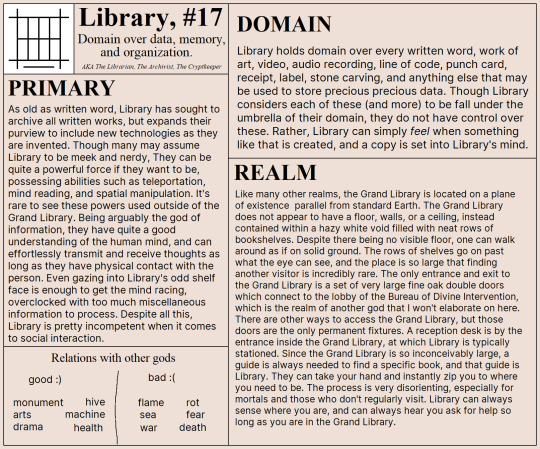
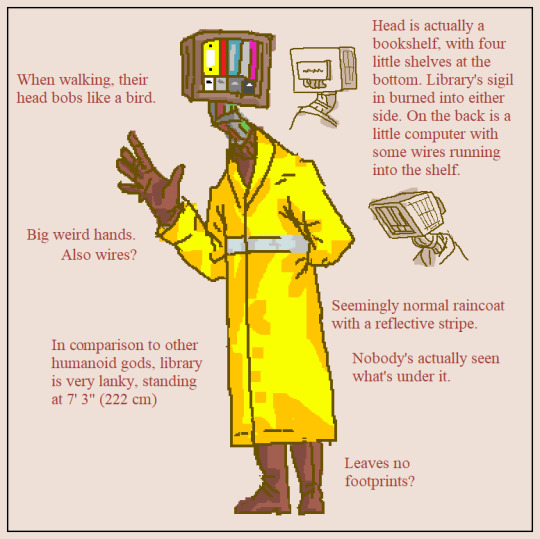
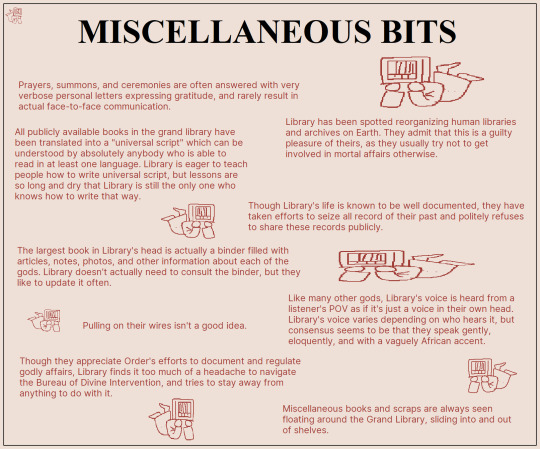
The next god to receive a bio is being voted on now here!
Image 1:
[This one is divided into sections, kinda like a newspaper. The specific formatting isn't really relevant, and it's pretty plain anyway.
Library, #17
Domain over data, memory, and organization.
AKA The Librarian, The Archivist, The Cryptkeeper
[Next to this first section of text is a neat black and white drawing of Library's sigil, a simple symbol comprised of a 2x4 grid of eight rectangles forming a square. The borderlines of the square extend a little past the corners, and an extra line lays horizontal at the bottom of the symbol.]
(next section of text)
PRIMARY:
As old as written word, Library has sought to archive all written works, but expands their purview to include new technologies as they are invented. Though many may assume Library to be meek and nerdy, They can be quite a powerful force if they want to be, possessing abilities such as teleportation, mind reading, and spatial manipulation. It's rare to see these powers used outside of the Grand Library. Being arguably the god of information, they have quite a good understanding of the human mind, and can effortlessly transmit and receive thoughts as long as they have physical contact with the person. Even gazing into Library's odd shelf face is enough to get the mind racing, overclocked with too much miscellaneous information to process. Despite all this, Library is pretty incompetent when it comes to social interaction.
(next section of text)
DOMAIN:
Library holds domain over every written word, work of art, video, audio recording, line of code, punch card, receipt, label, stone carving, and anything else that may be used to store precious precious data. Though Library considers each of these (and more) to be fall under the umbrella of their domain, they do not have control over these. Rather, Library can simply feel when something like that is created, and a copy is set into Library's mind.
(next section of text)
REALM:
Like many other realms, the Grand Library is located on a plane of existence parallel from standard Earth. The Grand Library does not appear to have a floor, walls, or a ceiling, instead contained within a hazy white void filled with neat rows of bookshelves. Despite there being no visible floor, one can walk around as if on solid ground. The rows of shelves go on past what the eye can see, and the place is so large that finding another visitor is incredibly rare. The only entrance and exit to the Grand Library is a set of very large fine oak double doors which connect to the lobby of the Bureau of Divine Intervention, which is the realm of another god that I won't elaborate on here. There are other ways to access the Grand Library, but those doors are the only permanent fixtures. A reception desk is by the entrance inside the Grand Library, at which Library is typically stationed. Since the Grand Library is so inconceivably large, a guide is always needed to find a specific book, and that guide is Library. They can take your hand and instantly zip you to where you need to be. The process is very disorienting, especially for mortals and those who don't regularly visit. Library can always sense where you are, and can always hear you ask for help so long as you are in the Grand Library.
(next section of text)
Relations with other gods:
good: monument, arts, drama, machine, health, hive
bad: flame, sea, war, death, rot, fear
(end of the first image)
Image 2:
[Standing in the center of the image is a tall, slim figure with one hand behind their back and the other raised to wave awkwardly. They are wearing a plain yellow raincoat that conceals most of their body, and brown gloves and boots. Their neck is long, curved, and round, made up of a thick tube of wires with a metal zip-tie keeping them in place. Their head is a cubic bookshelf, with the open side of the bookshelf acting as their face. The multicolored books within the shelf head are arranged in a way that resembles the static color bars of an old CRT TV. There are two more doodles of their head from two different angles, which are described in upcoming text so I'll leave it out here. Around the figure are bits of text that kinda correspond to various physical features of the god.]
(these are the bits of text:)
When walking, their head bobs like a bird.
head is actually a bookshelf, with four little shelves at the bottom. Library's sigil in burned into either side. On the back of their head is a little computer with some wires connected running seamlessly into the shelf.
Big weird hands. Also wires?
Seemingly normal raincoat with a reflective stripe. Nobody's ever actually seen what's under it.
in comparison to other humanoid gods, library is very lanky, standing at 7'3" (222 cm).
Leaves no footprints?
(end of the second image)
Image 3:
[This one has sentences and paragraphs placed around without much purpose. There was some empty space, so I copy + pasted the same doodle of Library laying on their stomach with their feet in the air, but I stretched out the doodles to make em look sillier.]
MISCELLANEOUS BITS:
Prayers, summons, and ceremonies are often answered with very verbose personal letters expressing gratitude, and rarely result in actual face-to-face communication.
Library has been spotted reorganizing human libraries and archives on Earth. They admit that this is a guilty pleasure of theirs, as they usually try not to get involved in mortal affairs otherwise.
All publicly available books in the grand library have been translated into a "universal script" which can be understood by absolutely anybody who is able to read in at least one language. Library is eager to teach people how to write universal script, but lessons are so long and dry that Library is still the only one who knows how to write that way.
Though Library's life is known to be well documented, they have taken efforts to seize all record of their past and politely refuses to share these records publicly.
The largest book in Library's head is actually a binder filled with articles, notes, photos, and other information about each of the gods. Library doesn't actually need to consult the binder, but they like to update it often.
Like many other gods, Library's voice is heard from a listener's POV as if it's just a voice in their own head. Library's "voice" varies depending on who hears it, but consensus seems to be that they speak gently, eloquently, and with a vaguely African accent.
Pulling on their wires isn't a good idea.
Though they appreciate Order's efforts to document and regulate godly affairs, Library finds it too much of a headache to navigate the Bureau of Divine Intervention, and tries to stay away from anything to do with it.
Miscellaneous books and scraps are always seen floating around the Grand Library, sliding into and out of shelves.
(end of third image)
This is the most I've had to describe, but lucky me, most of the images are just comprised of text. If there's any unexpected issues with this plain text version, please let me know. Even if it's just nitpicks, I'd love to hear it.
Thank you for reading/listening to my silly thing :^)
48 notes
·
View notes
Note
One thing I'm headscratching about WRT the 'one save' rule being 'untested': what exactly would you call the fall of Beacon? Yang's maimed, out cold (again) & on the verge of execution, but not a peep from the egg donor who likely link-sensed at least some of that. I mean, the rule itself is also probably 'more of a guideline', but so far as 'mom hasn't been there and still won't bar Something Big', message sent.
i mean. the time for raven to intervene then would have been before adam sliced off yang’s arm, there is no way she could possibly have anticipated and reacted in time to prevent that in the span between yang rushing forward and losing the arm two seconds later, and in about the time i imagine it would take to process the VERY SUDDEN tempo change from “yang is scared but not in imminent danger” to “DISMEMBERMENT?!” yang had been scooped up by her teammate and rushed to safety.
remember that adam’s slow, threatening advance in that moment was toward an illusory copy of them that blake left behind; yang was not on the floor longer than a couple seconds before blake got her.
we don’t know exactly how raven’s danger alert works but her semblance does seem to feed her enough spatial information for her to know things like yang being moved. (there is… also a nonzero possibility raven was there in bird form, given she was hanging around qrow that way earlier in the volume, in which case the semblance question would be moot)
whereas on the train, yang was unconscious and had no one else there. (notice also the delay between yang getting knocked out and raven port along in: we see in other contexts that over long distances, her portals take a bit of time to open at the other end)
raven’s “saves” seem to mean “if a bond of mine WILL DIE without my immediate intervention, i will intervene. once.” not “if you’re severely injured and a teammate of yours rushes to your aid and gets you out of there, i’ll appear to thwack the guy who hurt you.” and that’s a line she draws because she is desperately trying to hide that she cares.
but in vacuo she’s going to be trying to hide that less and the “rule” is going to turn out to be bullshit as soon as she stops posturing.
23 notes
·
View notes
Text
The Intersection of NLP Eye Movement Integration and the Lesser Banishing Ritual of the Pentagram: A Comparative Analysis

Introduction
Neuro-Linguistic Programming (NLP) has long been associated with cognitive restructuring and psychotherapeutic interventions. One particularly compelling technique within NLP is Eye Movement Integration (EMI), which utilizes guided eye movements to access and integrate fragmented or traumatic memories. Simultaneously, the Lesser Banishing Ritual of the Pentagram (LBRP), a foundational ceremonial magick practice from the Western esoteric tradition, employs ritualized gestures and visualizations of pentagrams to clear and harmonize psychological and spiritual space. This essay explores the striking structural similarities between EMI and the LBRP and considers the possibility that both methods engage hemispheric synchronization and cognitive integration in analogous ways.
The Structure of EMI and LBRP
Eye Movement Integration (EMI) involves tracing figure-eight (∞) or infinity-loop movements with the eyes while engaging in conscious recall of emotionally charged experiences. According to NLP theories, this process activates both hemispheres of the brain, allowing for greater coherence in how memories are processed and reintegrated (Bandler & Grinder, 1982). EMI techniques suggest that deliberate movement across specific spatial axes stimulates neural pathways responsible for sensory and emotional integration (Ward, 2002).
Similarly, the LBRP involves a structured sequence of visualized pentagrams drawn in the cardinal directions, accompanied by divine names and ritual gestures. This sequence is designed to invoke protective forces and create a harmonized psychic field. According to the Golden Dawn tradition (Cicero, 1998), the act of tracing the pentagram is intended to engage multiple layers of cognition: visual-spatial processing, linguistic invocation, and kinesthetic anchoring.
Shared Cognitive and Psychological Mechanisms
Bilateral Stimulation and Neural Integration
Both EMI and LBRP involve movements across spatial dimensions that engage both brain hemispheres.
EMI’s horizontal and diagonal eye movements mimic the process of following the pentagram’s path in ritual, possibly facilitating left-right hemisphere synchronization (Bandler & Grinder, 1982).
Symbolic Encoding and Cognitive Anchoring
EMI often integrates positive resource states during the eye-tracing process, allowing new neurological connections to be formed. The LBRP similarly encodes protective and stabilizing forces into the practitioner’s consciousness through repeated use of divine names and pentagram tracings (Cicero, 1998).
The act of drawing a pentagram in ritual space may serve as an ‘anchor’ to a specific neurological or psychological state, much like NLP anchoring techniques (Hine, 1995).
Emotional and Energetic Reset
EMI is used to defragment and neutralize distressing memories, reducing their disruptive impact. The LBRP, in an esoteric context, serves to “banish” intrusive or unwanted energies, clearing space for more intentional psychological and spiritual work (Cicero, 1998).
Practitioners of both techniques report a sense of clarity, release, and heightened awareness following their use (Hine, 1995).
Implications for Technomagick and NLP Applications
The intersection of NLP and ceremonial magick suggests that structured, repetitive movement combined with intentional focus has profound cognitive and psychological effects. In a Neo-Technomagickal framework, this insight could lead to further experimentation with custom sigils designed for EMI-style integration, or AI-assisted visualization tools for ritual practice.
Future research could examine:
Whether specific geometries (e.g., pentagrams, hexagrams) in ritual movement impact cognitive processing similarly to NLP techniques.
The effectiveness of LBRP-derived rituals in clinical or self-development contexts, particularly for trauma resolution.
The potential for EEG and neurofeedback studies comparing EMI and ritualized eye-tracing methods.
Conclusion
While originating from vastly different paradigms, NLP’s EMI technique and the LBRP share fundamental principles of hemispheric integration, cognitive anchoring, and structured movement through symbolic space. Whether consciously designed or stumbled upon through esoteric practice, these methodologies hint at deep underlying mechanisms of the human mind’s capacity for self-regulation and transformation. Understanding their similarities provides an opportunity to bridge the domains of magick, psychology, and neuroscience, opening new avenues for exploration in both mystical and therapeutic contexts.
G/E/M (2025)

References
Bandler, R., & Grinder, J. (1982). Reframing: Neuro-Linguistic Programming and the Transformation of Meaning. Real People Press.
Cicero, C. & Cicero, S. T. (1998). Self-Initiation into the Golden Dawn Tradition. Llewellyn Publications.
Hine, P. (1995). Condensed Chaos: An Introduction to Chaos Magic. New Falcon Publications.
Ward, K. (2002). Mind Change Techniques to Keep the Change. NLP Resources.
#magick#technomancy#chaos magick#neotechnomagick#neotechnomancer#cyber witch#neotechnomancy#cyberpunk#technomagick#technology#nlp#nlp training#nlp techniques#nlp practitioner#natural language processing#artificialintelligence#nlp coach#neurocrafting#neuromancer#neuroscience#neuro linguistic programming
9 notes
·
View notes
Text

Hello loves, welcome to my Masterlist! Last Updated: 12/29/24
─────── ˖ ࣪⊹˚⁺⋆⋅☆⋅⋆⁺˚⊹ ࣪ ˖ ────────
ABOUT ME
I'm both a writer and an artist, meaning for most fics I write, art will most likely be included! I write a variety of content, but I mainly tend to stick with AU's, as I find them the most enjoyable to write. ♡
That being said, I'm also a student. Please try to be patient with me, life can get busy. ♡
I currently don't really take requests, and am not comfortable writing nsfw content. But who knows, that might change in the future (I'll let you know *wink wink*)! ♡
Don't be afraid to share any ideas you've got in that unhinged head of yours, I'd love to hear them! This is a safe place, so be as cringe and crazy as you want, no judgement from me! ♡
─────── ˖ ࣪⊹˚⁺⋆⋅☆⋅⋆⁺˚⊹ ࣪ ˖ ────────
I recently posted my first fic, titled Divine Intervention, and it's a YamiFin one! YIPPE! I personally think there isn't enough of this rarepair (and Finral focus in general), so here is my contribution. Enjoy!
Click here to read the fic, feel free to check it out!
My Archive user is: AngieTheBangie
─────── ˖ ࣪⊹˚⁺⋆⋅☆⋅⋆⁺˚⊹ ࣪ ˖ ────────
DIVINE INTERVENTION
Finral was no stranger to fear or pain. However, nothing compared more than the aching emptiness he was left with when his parents disowned him. Desperate to survive, the spatial angel is left with no choice but to accept the only job willing to take him.
The Angel Messenger, otherwise known as the most looked down upon profession there was, who delivers letters straight to demons. The more he's around demons, the more he realizes how misleading the stereotypes are. And so, Finral begins to wonder… what if the world wasn't as black and white as he was told it was? What if angels and demons really weren't all that different?
OR
The Angels and Demons AU that nobody asked for.
CHAPTER INDEX:
Art Gallery (character designs) Chapter 1: Loss of Innocence Chapter 2: Lending a Hand Chapter 3: Phases of The Moon Chapter 4: Ill Intentions
#finral roulacase x yami sukehiro#finral x yami#finral roulacase#vanessa enoteca#luck voltia#noelle silva#alternate universe#angels and demons#archive of our own#magna swing#asta black clover#black clover#masterlist#government corruption#heavy angst#attempt at humor#finral pov#original child character#original character#SEND HELP
7 notes
·
View notes
Video
Narratives of Birth : Poetics of Memory #4 by Russell Moreton Via Flickr: Architectural Intervention : Working Collage for Glass Fetal Medicine Centre Prosound SSD-5000 V4 ALOKA Astronomical Mapping/ Birth Scan Scale, Interior, Time, Spatial Presences, Human Becoming,
#Architectural#Intervention : Working Collage for Glass#Fetal Medicine Centre#Prosound SSD-5000 V4 ALOKA#Astronomical Mapping/ Birth#Scan Scale#Interior#Time#Spatial Presences#Human Becoming#low contrast#grey spaces#intersections#art and literature#birth scan#astronomy#chart#points#territories#light years#distance#proximity#scale#personal biography#russell moreton#research artist#visual cartography#evocative spaces#entanglements#colour and light
1 note
·
View note
Text
Captain's Log

(This piece was written as some side-lore for a spaceship full of skeletons who will be joining my tabletop players in this week's session. I really liked how it turned out, so I'm sharing it here!)
Stardate… uh, June.
The Cruiser's Inevitability Drive is on the fritz again. We've put in the obols and checked the Styxwater compressor, but we're not moving any faster than Death Factor: Bruise. If we really punch it we can get up to Clot or maybe Plague, but this frigate was designed to idle at DF: Lightning and punch up to Heart Attack.
We're as good as a sailboat.
The bonerboys know it, and they've been patient. Thoughtful, even. Calcifred and Marrone have been down in the engine room all hours of the day and night, making various tributes and alternately consecrating and desecrating the waters, then checking for results. Nothing so far, which indicates something much worse. I fear we may have a problem with the Central Psychostasia. Too much High Water on one side, not enough Hell on the other.
If that's the case, you can't just get Hell. You've got to initiate a Dante-priority breach and farm some out while the planar boundary is thin. We don't have an Osseomurderine on this crew- we had one, but had to leave her behind on Idyll 4 to keep the rampaging angel population in check. They were getting into gutters and attics looking for sin and being a real nuisance, so she talked us into letting her volunteer.
Without our O.M., all we have is her books. You know, the ones with the skittering runes in uncertain positions. Hard to sit down and study. You try to take notes and the notes start skittering, too. I fear what would happen if we used our computer systems to record the contents- I suspect a computer likes being able to find bits and bytes where it left them.
So it's a slog, but we're still on our mission. Our Vaunted Nightbringer has given us a heading, and we must bear down on it. The limpets are charged with fresh ghostgems, and as soon as one of the scouting limpets bites down on our target, we'll deploy the swarm and be sure of what we're chasing.
I'm told it's a damaged Superluminal craft. They might not have any Hell onboard- I'm not expecting a craft belonging to the living to have a Damnostatics or Osseometry deck- but I'm tempted to go pirate and help myself to either their Folden compressor, to address our Styxwater issue, or cut a hole in the bottom and drop their entire engine into our cargo bay to part-and-parcel our way into some kind of… what would you call it? Damno-hydro-lumino drive?
No such hope at the moment, though. A dispatch from O.V.N. just came over the blower. I'm to pick half a dozen of my best and board the vessel. Apparently the Head Lich In Charge has taken a liking to the grave-stuffers aboard, and has ordered our intervention.
Sensors show numerous spatial micro-anomalies within the hull of the ship. Pockets of gravitational waves and higher-dimensional distortion. It's strange, they show up on our sensors in what appear to be predefined shapes, like tetrominoes of folding space that grow stronger when connected to each other.
Dangerous. And well outside my wheelhouse. I'll make sure that the crew's arms and armor are freshly cursed and desecrated before boarding. As for me… I think I'll wear the Nito-I. It's bulky, but it inspires confidence, no?
Signing off,
Captain Manuel Calavera of the Casket Cruiser OVN Dauphin.
#star trek#skeleton#grim fandango#all of Our Vaunted Nightbringer's most prominent lieutenants are named after Video Game Skeletons lol#spirit of 77#is the game we're playing btw
3 notes
·
View notes
Text
[T]hey frequently transgress the spatial boundaries imposed by humans to organize and govern spaces […]. [W]etlands spread out and do not conform to the straight and consistent lines between land and water. […] The smells of wetlands, of decomposing vegetation, of sulphur, were […] off-putting for [British] settlers in Aotearoa […]. Soon after the British-led military invasion of the Waikato region in 1863 and the confiscation of 480 000 ha of Maori lands, [...] [t]he ‘great swamp region of the Waikato’ was described as a picture of ‘desolation’ and ‘stagnant water’ where the ‘ground quaked and quivered beneath’ one's feet, and opened up unexpectedly to suck people down into ‘horrible depths of [the] black, stinking bog’. […] The omnipresent dangers of ‘damp vapour arising’ were deemed ‘highly prejudicial to residents’ health throughout Aotearoa. […] The ‘tepid swamps’, it was reported, poisoned the ‘otherwise pure air’ […].’ The Napier Swamp Nuisance Act enabled local government officials to ‘fill in’ (meaning to drain, establish levees, and build up the soil) any parcel of land deemed a muddy watery odorous ‘nuisance’ without the consent of the landowners. […] [P]oliticians suggested [that Aotearoa] be decontaminated through strategic interventions to remove and remake wetlands […]. Such ideas, which fused medical and socio-economic theories, justified indigenous dispossession and drainage works […].
Text by: Meg Parsons and Karen Fisher. “Historical smellscapes in Aotearoa New Zealand: Intersections between colonial knowledges of smell, race, and wetlands.” Journal of Historical Geography Volume 74, pages 28-43. October 2021.
---
On 24 December 1928 Italy’s fascist regime launched […] a fourteen-year national land reclamation programme aimed at [...] Italy's ‘death inducing’ swamps […]. The Pontine Marshes, a marshland spreading across 75,000 hectares south of Rome was given top priority […]. [T]he fascist regime used an extensive propaganda machinery to promote the programme […] as a heroic quest for producing an 'ideal' [...] landscape [...]. Newsreels documented step by step the struggle […], with Mussolini himself often featuring, overseeing the project, or even working the land. […] Nearly 3,000 newsreels and many documentaries were produced [...]. This was [...] [among] Italy's most important public works project[s] [...], a transformative enterprise that [...] would engage with an "untamed" natural environment and [force] it into a sanitised version of ideal fascist nature. [...] [The marshes] were linked to the idea of wilderness, [...] undisciplined, uncivilised, and unproductive [...]. This policy […] aimed […] [at] removing “unhealthy” [...] areas, through the process of sventramento (disembowelment). […] The construction of New Towns [...] in the Pontine Marshes [...] aimed at producing the 'ideal' settlement [...]. [These newly constructed] municipal buildings often boasted prominent towers [....] reigning supreme over the Marshes [...].
Text by: Federico Caprotti and Maria Kaika. “Producing the ideal fascist landscape: nature, materiality and the cinematic representation of land reclamation in the Pontine Marshes.” Social & Cultural Geography Volume 9. 2008.
---
[I]n Recife in the Northeast of Brazil [...] the transformation of the city was predicated on [...] [a] notion of whiteness that required the enclosure of wet, amphibious space to make dry land. [...] Racialised groups – of black, indigenous, and mixed heritages – and the houses, marshlands, and mangroves where they lived, were subject to eradication [...]. [F]rom the 1920s to 1950s, during the rise to hegemony in Brazil of [a form of eugenicist, modernist nationalism,] [...] [the] idea's heartland [was] the Northeast. [...] Recife is also a centre of Brazilian black culture [...]. One of the key sites in Brazil's slave and sugar trades [...], the city was [...] [a] hub. Many of these people lived in what came to be called mocambos, a word that designated an informal dwelling, but came to mean much more. [...]. Mocambos were seen as [...] the place where exploited labour was kept out of sight. [...] They were also [...] the inheritance [...] of the quilombo - the community of escaped slaves. [...] In July 1939, the proto-fascist administration [...] of Agamenon Magalhães, put in place by Getúlio Vargas' repressive Estado Novo, launched the Liga Social Contra o Mocambo (Social League Against the Mocambo, LSCM). The League emerged out of a tellingly named “Crusade” against the mocambos. [...] Mocambos were characterised as repellent, unhygienic, and dangerous: “the mocambo which repels. The mocambo which is the tomb of a race … a sombre landscape of human misery … which mutilates human energy and annuls work" [...]. These were the decades of the embranquecimento of the Brazilian population through public policies of immigration, miscegenation, and sterilisation [...]. This white supremacist ideology was inseparably a politics of nature. Magalhães wrote [in 1939]: The idle life, the life that the income of the mocambos provides [...]. It is a life of stagnant water. … [that] generates in its breast the venom of larvae, which are the enemies of life. Enemies of life, as are the mocambos and the sub-soil of cities, where the polluted waters contaminate pure waters [...]. Attempts to “cleanse” the city functioned through a distinct process: aterramento, the making of land. [...] Or as 1990s mangue beat [mangrove beat] musicians [...] put it, “the fastest way also to obstruct and evacuate the soul of a city like Recife is to kill its rivers and fill up its estuaries” [...].
Text by: Archie Davies. "The racial division of nature: Making land in Recife". Transactions of the Institute of British Geographers Volume 46, Issue 2, pp. 270-283. First published 29 November 2020.
#geographic imaginaries#multispecies#ecologies#tidalectics#archipelagic thinking#black methodologies#indigenous pedagogies#indigenous#ecology#agents of empire
130 notes
·
View notes
Text
How Does The Brain Work?
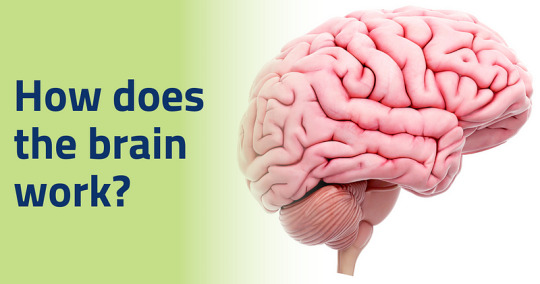
The brain stands as a marvel of biological engineering, Composing of a multitude of bodily functions ranging from cognition and memory to emotions and sensory perception. Together with the spinal cord, it constitutes the central nervous system (CNS), the command center of the human body.
Composition of the Brain
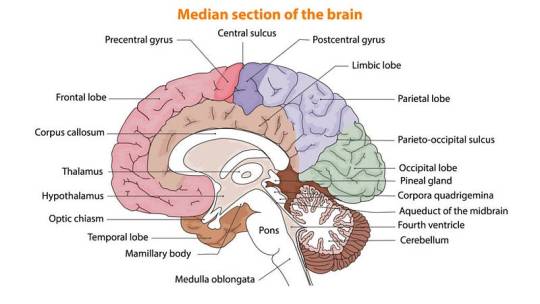
Weighing approximately 3 pounds in adults, the brain’s main structure comprises about 60% fat, interspersed with water, protein, carbohydrates, and salts. Unlike muscles, it houses a complex network of blood vessels and nerves, including neurons and glial cells.
a) Gray and White Matter
Within the central nervous system, gray matter and white matter occupies distinct regions. In the brain, gray matter forms the outer layer, rich in neuron somas, while white matter constitutes the inner section, primarily composed of axons unsheathed in myelin. Conversely, in the spinal cord, this arrangement is reversed.
b) Brain Functionality
The brain operates by transmitting and receiving chemical and electrical signals throughout the body. These signals regulate a myriad of processes, with the brain disseminating each input. Some signals remain confined within the brain, while others traverse the spinal cord and nerves, disseminating information across the body’s expanse. This composes neural network relies on billions of interconnected neurons.
Major Brain Regions and Their Functions
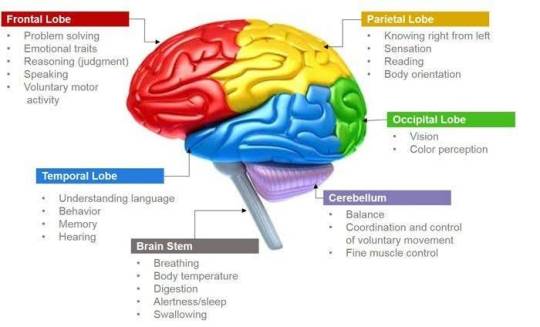
1.Cerebrum
Dominating the brain’s landscape, the cerebrum encompasses the cerebral cortex and underlying white matter. It governs a spectrum of functions, including motor coordination, temperature regulation, language processing, emotional regulation, and sensory perception.
2. Brainstem
Serving as the bridge between the cerebrum and spinal cord, the brainstem comprises the midbrain, pons, and medulla. It regulates vital autonomic functions such as heart rate, breathing, and reflexive responses.
3. Cerebellum
Nestled at the posterior aspect of the brain, the cerebellum coordinates voluntary muscle movements, posture, balance, and motor learning.
Brain Coverings
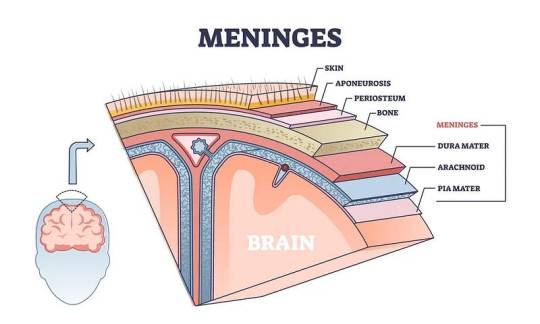
a) Meninges
Three layers of protective membranes, collectively known as meninges, enshroud the brain and spinal cord. These layers — dura mater, arachnoid mater, and pia mater — shield the delicate neural tissue from physical trauma and infection.
b) Lobes of the Brain
Each hemisphere of the brain comprises four lobes, each harboring distinct functional domains:
Frontal Lobe: Governing executive functions, motor control, and higher cognitive processes.
Parietal Lobe: Integrating sensory information, spatial awareness, and perception of pain and touch.
Occipital Lobe: Specialized for visual processing and perception.
Temporal Lobe: Involved in auditory processing, language comprehension, and memory consolidation.
Deeper Brain Structures
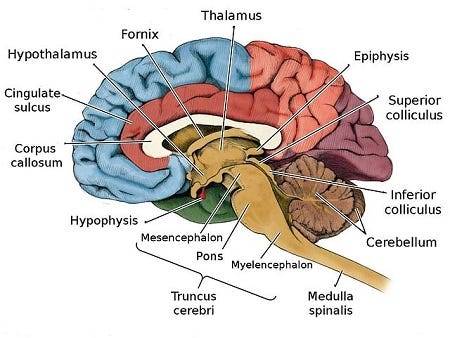
These encompass important structures such as the pituitary gland, hypothalamus, amygdala, hippocampus, and pineal gland, orchestrating hormone secretion, emotional regulation, memory consolidation, and circadian rhythms.
Blood Supply
The brain receives its oxygenated blood supply through the vertebral and carotid arteries, ensuring adequate perfusion of neural tissue. The main network of blood vessels, including the Circle of Willis, safeguards against ischemic insults and facilitates intraarterial communication.
Cranial Nerves
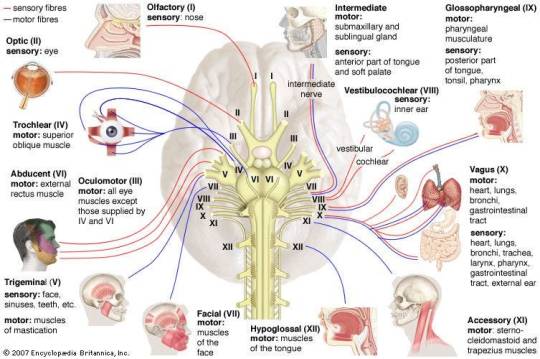
The twelve pairs of cranial nerves, originating from the brainstem, mediate a diverse array of sensory and motor functions, encompassing olfaction, vision, facial expression, and auditory perception.
Comprehending the anatomy and functionality of the brain fosters a deeper appreciation of its complexity and facilitates advances in neuroscientific research and therapeutic interventions aimed at diminishing neurological disorders.
Understanding the detailed anatomy and functionality of the brain is crucial for medical students embarking on their journey of study. Expert Academic Assignment Help offers invaluable assistance in navigating the complexities of neuroscience and related subjects. By leveraging expert guidance and support, students can excel in their medical education and contribute to advancements in the field of Medicine. Email us at [email protected] to embark on your path to scholarly excellence and professional competency.
#studying#studyblr#study blog#study aesthetic#student life#student#medical student#medical school#medicine#university student#university#university life#assignment help#medical students#nursing student#nursing school#healthcare#health and wellness#mental health#psychology#phd life#phd thesis writing service#online writing#do my online class#academic writing#essay writing#academic assignments#academia
17 notes
·
View notes
Text

Curved Attic is a minimal home located in Valencia, Spain, designed by Destudio. The project, as the name suggests, demonstrates how architectural intervention can transform spatial constraints into poetic advantages, particularly through its thoughtful integration of a sculptural spiral staircase that serves as both a functional element and a dramatic centerpiece.
31 notes
·
View notes